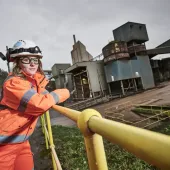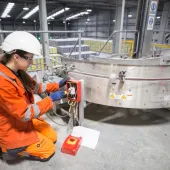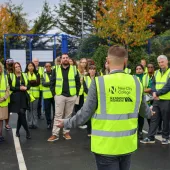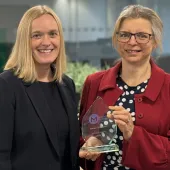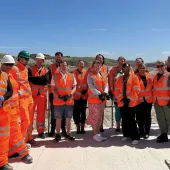Flagging up Quarrying’s Leadership Gap

First published in the April 2017 issue of Quarry Management
By David Cartwright, founder of online learning platform OBD Academy
The talent future looks to be in well-invested hands, particularly for businesses requiring technical or vocational resource. This month, we will welcome the Apprenticeship Levy and, following the Chancellor’s spring budget, can look forward to the introduction of T-levels. These new qualifications boast a ‘high-quality’ three-month placement for every student and an extra 50% increase in the number of training hours for 16- to 19-year-old technical students.
Plans that have at their core the objective of helping people to be the best they can be must be applauded. For many people, despite apparent success in their career, their true potential remains latent throughout their lifetime.
That the Apprenticeship Levy is named a levy and, in some quarters, a ‘training tax’, says much about our attitude towards investing in our most important asset – people. Investment in people is seen as discretionary spend rather than critical investment and, consequently, an easy target for cost saving. Would we make such compromises with the maintenance of capital equipment or our IT mainframe? Certainly not; these are seen as critical to keeping business running and, in many cases, to complying with health, safety and environmental requirements.
Given the UK’s industrial and engineering heritage, one can perhaps understand this investment bias in machinery over people. However, we now need to refocus our priorities by promoting the maintenance of our people on to the same level, at least, as maintaining machinery.
We are informed of businesses failing to achieve their potential and that employee disengagement is the root cause. Estimates vary from six to eight out of 10 employees being disengaged across industries. Can you imagine your capital equipment being out of action for 80% of its expected use? Of course not; once back on track, a witch-hunt would be quickly organized to weed out those responsible for the technical failure. So why do we barely raise an eyebrow to such damaging statistics about our people? Is it because business leaders do not really believe that their people can make a difference or, that their engagement is something they are simply unable to influence?
Employee engagement is the subject of one of The Institute of Quarrying’s own Engagement, Influence and Impact series of factsheets (www.quarrying.org/iq-knowledge/factsheets). It refers to employee engagement by making the distinction between a disengaged employee, ‘just going through the motions’ and an engaged one, ‘putting their heart and soul into a job’. In conclusion, it suggests that this analogy ‘should make sense to everyone’. It does indeed make sense, and leads on to the very important question of how this engagement might be achieved and what this might look like in practice for all. The fact is that the environment in which we all work is down in no small way to the quality of leadership alongside us.
However, leaders have a tendency to overlook or downgrade their responsibility to the development and well-being of their people, believing that their seniority and time-served experience are sufficient to engage and enthuse. No longer are gainful employment and the monthly credit into our bank account sufficient to force superlative effort. The extra mile or ‘discretionary effort’, as I like to call it, is something that is fostered by a leader’s comfort and confidence to engage with his or her team, both individually and collectively.
So, what sort of leaders does the quarrying industry need and how does this differ from what we have been served up over the preceding decades?
What we now speak of as employee engagement was in the past referred to as industrial relations – a conflict-rich environment in which two adversarial groups did battle. Whilst the term industrial relations may now have been banished from the lexicon of ‘leadership speak’, its ethos remains a defining undercurrent of leadership behaviour.
Many of today’s quarrying industry leaders are ‘baby boomers’ weaned into the world of work on the back of a hierarchical command and control culture. So, perhaps it should not be a surprise to learn that employee engagement has not yet filtered through into the consciousness of leadership understanding and into their resultant behaviours.
Employee engagement is not a top down command to the troops to get on board and rally round; nor is it a series of ‘smiley face’ initiatives designed to make everyone feel part of the wider family. It is about creating the working environment in which people feel confident to fulfil their obligations and supported enough to go ‘off piste’ when faced with the unexpected.
It is about identifying the development needs of an individual to perform well within a role and to reconcile their appetite and ambition for future roles. It is also about having honest conversations about performance, expectation and the future. If we want people to ‘put their heart and soul into a job’ we must detail what this will look and feel like, and be prepared to demonstrate these values personally. If the environment is supportive, challenging and understood, engagement will more likely follow.
The skills and knowledge with which we entered the world of work were never intended to last us a lifetime. They were simply the platform on to which new skills and experiences could be added and new capabilities developed. People have a psychological need to be developed; it is part of what differentiates us from the rest of the animal kingdom. If we are not developing, we are stagnating and thus rendering ourselves obsolete.
Rather than people development being seen as a burden of responsibility to offload on to a willing central function (ie human resources), it should be viewed as a leader’s primary accountability. Is this not the reason why leaders are rewarded at a higher level than the people they lead? Yes, they have commercial and legal duties to attend to and targets to deliver against, but making it happen is down to the team. The performance of a team is inextricably linked to the way in which a leader leads and engages with his or her colleagues.
Quarrying needs to equip its people to deliver today and be resourced to deliver tomorrow. If people do not feel properly equipped and supported they will be unable to perform to their capacity. It is rare for people lacking in confidence within their current role to feel sufficiently emboldened to deal with unexpected live events or to accept greater responsibility than is currently expected of them.
The fundamental objective of a people strategy is to create a skilled and confident workforce, by giving people the tools to perform to their best within their role and to develop their potential to fulfil future roles. We will not know the exact nature of these future roles but we can assume they will require a growing level of commercial and leadership acumen. So, whilst initiatives as described earlier in this article are to be encouraged, we must ensure that our investment adds value to our people, our organizational capacity and our long-term performance.
In many organizations, significant investment is required in maintaining health, safety and environmental controls. Whilst necessary, they confirm adherence to minimum standards, mandated by an appropriate legislative body. Your people will view this as compulsory education rather than personal development.
It is easy to throw money in the hope that some of it sticks, but with greater involvement from leaders in knowing what is needed, the various modalities to suit different learning preferences and their own role in supporting this development, whatever investment is made, will be better utilized.
In developing our people to be at capacity we are in effect making our business stronger and more resilient to whatever the future holds. In doing so, we also make it explicit that we value their continuing contribution.
Organizational development and management writer Charles Handy said: ‘For the first time in the human experience we have a chance to shape our work to suit the way we live, instead of our lives to fit our work…we would be mad to miss this chance’. That is great news for us as individuals, but it also represents a massive challenge for leaders.
In the fullness of time I expect the term leader to be augmented with the word coach, to become coach leader. A coach leader is someone who recognizes not only the choice to which Charles Handy referred, but also the importance of their role in developing the capability and potential of others. In this environment people are more likely to give of their best and be even more receptive and supportive to the evolving demands of a business. In a world where change is the only constant, this dynamic capability is not just desirable, it is essential to a company’s very survival.
But what about the leader? The world of work is changing and the current cohort of quarrying industry leaders is not only trying to meet exacting objectives, they are also being asked to change some of the lifelong behaviours. If they are to transition to a coach leader role then they too will need encouragement and supportive challenge to feel sufficiently confident to face a new way of leading. After all, leaders are simply people with more opportunity to influence. That should not be underestimated.
Quarrying is steeped in history and is more labour intensive than the service- and knowledge-focused sectors. According to Mark Carney, the governor of the Bank of England, robots are queuing to replace people across sectors. Yes, automation continues to gather pace and few feel confident to predict the journey it will take us on. However, robots can only take over those roles that they are qualified to do and, as of this moment, I am unaware of any robot being capable of leading, inspiring, engaging and innovating. For the time being, these aptitudes are firmly in our human camp and it would be negligent of us not to focus on making the most of these talents for the benefit of all.
For more information visit: www.obd-academy.com
- Subscribe to Quarry Management, the monthly journal for the mineral products industry, to read articles before they appear on Agg-Net.com


